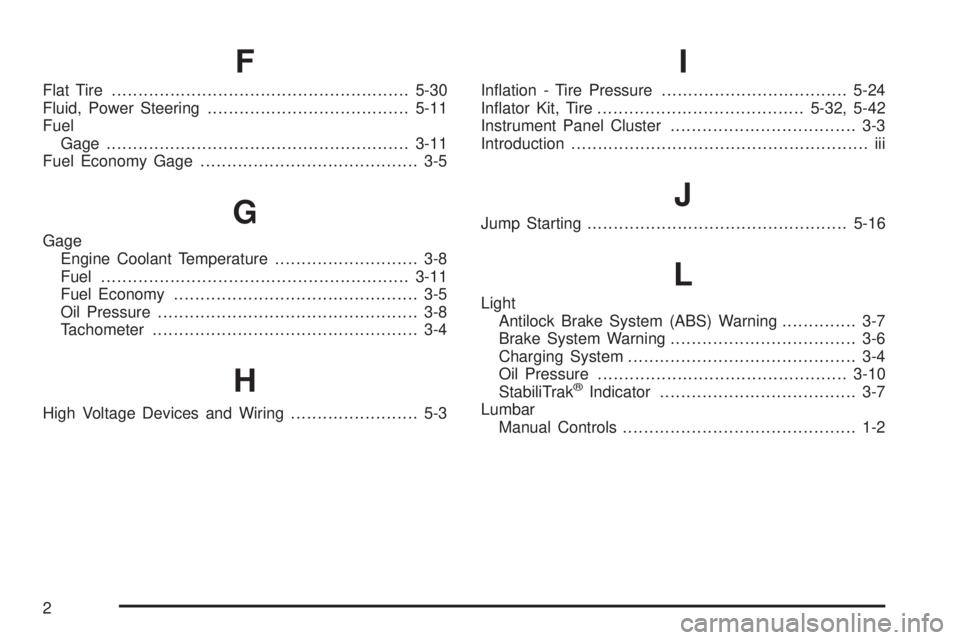2009 GMC YUKON HYBRID brake fluid
[x] Cancel search: brake fluidPage 37 of 94

Service............................................................5-2
Doing Your Own Service Work.........................5-2
Checking Things Under the Hood.....................5-3
High Voltage Devices and Wiring......................5-3
Engine Compartment Overview.........................5-4
Automatic Transmission Fluid...........................5-5
Drive Motor/Generator Control Module (DMCM)
Coolant Surge Tank Pressure Cap..................5-6
Drive Motor/Generator Control Module (DMCM)
Cooling System...........................................5-6
Power Steering Fluid.....................................5-11
Brakes........................................................5-11
Battery........................................................5-15
Jump Starting...............................................5-16
Bulb Replacement..........................................5-21
Taillamps, Turn Signal, Stoplamps and
Back-up Lamps.........................................5-21
Replacement Bulbs.......................................5-22Electrical System............................................5-22
Fuses and Circuit Breakers............................5-22
Underhood Fuse Block..................................5-22
Tires..............................................................5-24
Inflation - Tire Pressure.................................5-24
Tire Pressure Monitor Operation.....................5-25
Tire Inspection and Rotation...........................5-29
Tire Chains..................................................5-30
If a Tire Goes Flat........................................5-30
Tire Sealant and Compressor Kit
(Without Selector Switch)............................5-32
Tire Sealant and Compressor Kit
(With Selector Switch)................................5-42
Tire Sealant and Compressor Kit Storage.........5-50
Capacities and Speci�cations..........................5-52
Section 5 Service and Appearance Care
5-1
Page 41 of 94

A. See “Engine Air Cleaner/Filter” in the owner manual.
B. Drive Motor/Generator Control Module (DMCM).
SeeDrive Motor/Generator Control Module (DMCM)
Cooling System on page 5-6.
C. Engine Oil Dipstick. See “Engine Oil” in the owner
manual.
D. Automatic Transmission Fluid Dipstick. See
Automatic Transmission Fluid on page 5-5.
E. Brake Fluid Reservoir. SeeBrakes on page 5-11.
F. See “Underhood Fuse Block” in the owner manual.
G. See “Windshield Washer Fluid” in the owner
manual.
H. Hybrid Auxiliary Fuse Block. SeeUnderhood Fuse
Block on page 5-22.
I. DMCM Coolant Surge Tank Pressure Cap. See
Drive Motor/Generator Control Module (DMCM)
Coolant Surge Tank Pressure Cap on page 5-6.
J. See “Coolant Surge Tank Pressure Cap” in
the owner manual.
K. Engine Oil Fill Cap. See “Engine Oil” in the owner
manual.Automatic Transmission Fluid
For more information, see “Automatic Transmission
Fluid” in the owner manual Index.
Checking the Fluid Level
Your vehicle’s automatic transmission dipstick looks like
this. For more information on location, seeEngine
Compartment Overview on page 5-4.
5-5
Page 47 of 94

Power Steering Fluid
The vehicle has electric power steering and does not
use power steering fluid.
Brakes
Brake Fluid
The brake master cylinder
reservoir is filled with
DOT-3 brake fluid. See
Engine Compartment
Overview on page 5-4
for the location of
the reservoir.
There are only two reasons why the brake fluid level in
the reservoir might go down:
•The brake fluid level goes down because of normal
brake lining wear. When new linings are installed,
the fluid level goes back up.
•A fluid leak in the brake hydraulic system can also
cause a low fluid level. Have the brake hydraulic
system fixed, since a leak means that sooner
or later the brakes will not work well.Do not top off the brake fluid. Adding fluid does not
correct a leak. If fluid is added when the linings
are worn, there will be too much fluid when new brake
linings are installed. Add or remove brake fluid, as
necessary, only when work is done on the brake
hydraulic system.
{CAUTION:
If too much brake fluid is added, it can spill on
the engine and burn, if the engine is hot enough.
You or others could be burned, and the vehicle
could be damaged. Add brake fluid only when
work is done on the brake hydraulic system.
See “Checking Brake Fluid” in this section.
When the brake fluid falls to a low level, the brake
warning light comes on. See “Brake System Warning
Light” in the owner manual.
Refer to the Maintenance Schedule to determine when
to check the brake fluid. See “Scheduled Maintenance”
in the owner manual.
5-11
Page 48 of 94

Checking Brake Fluid
Check brake fluid by looking at the brake fluid reservoir.
SeeEngine Compartment Overview on page 5-4.
With the engine not running for at least one minute, the
maximum fluid level (A) is at the top of the reservoir
body. With the engine running, the fluid level should be
in the proper operating range (B) between the MIN
and MAX marks. If it is not, have the brake hydraulic
system checked to see if there is a leak.After work is done on the brake hydraulic system,
make sure the level, with the engine running, is in
the proper operating range (B) between the MIN and
MAX marks.
What to Add
Use only new DOT-3 brake fluid from a sealed
container. See “Recommended Fluids and Lubricants”
in the owner manual.
Always clean the brake fluid reservoir cap and the area
around the cap before removing it. This helps keep
dirt from entering the reservoir.
{CAUTION:
With the wrong kind of fluid in the brake hydraulic
system, the brakes might not work well. This could
cause a crash. Always use the proper brake fluid.
5-12
Page 91 of 94

A
Alternating Current
Power Outlet................................................ 2-2
Antilock Brake, System Warning Light.................. 3-7
Audio System(s)
Navigation/Radio System..............................3-14
Automatic Transmission, Fluid............................ 5-5
B
Battery..........................................................5-15
Brake Fluid....................................................5-11
Brakes..........................................................5-11
Regenerative Braking...................................2-10
System Warning Light.................................... 3-6
Bulb Replacement
Taillamps, Turn Signal, Stoplamps and
Back-up Lamps........................................5-21
C
Canadian Owners................................................ ii
Capacities and Specifications............................5-52
Chains, Tire...................................................5-30
Charging System Light...................................... 3-4Climate Controls............................................... 3-2
Compressor Kit
Storing.......................................................5-50
Compressor Kit, Tire Sealant....................5-32, 5-42
Coolant
Engine Temperature Gage.............................. 3-8
Coolant Surge Tank Pressure Cap, (DMCM)......... 5-6
Cooling System, (DMCM).................................. 5-6
D
Drive Motor/Generator Control Module (DMCM)
Coolant Surge Tank Pressure Cap................... 5-6
Drive Motor/Generator Control Module (DMCM)
Cooling System............................................. 5-6
Driver Information Center (DIC).........................3-12
Warnings and Messages...............................3-12
E
Engine
Compartment Overview.................................. 5-4
Coolant Temperature Gage............................. 3-8
Drive Belt Routing......................................... 6-2
1
Page 92 of 94

F
Flat Tire........................................................5-30
Fluid, Power Steering......................................5-11
Fuel
Gage .........................................................3-11
Fuel Economy Gage......................................... 3-5
G
Gage
Engine Coolant Temperature........................... 3-8
Fuel..........................................................3-11
Fuel Economy.............................................. 3-5
Oil Pressure................................................. 3-8
Tachometer.................................................. 3-4
H
High Voltage Devices and Wiring........................ 5-3
I
Inflation - Tire Pressure...................................5-24
Inflator Kit, Tire.......................................5-32, 5-42
Instrument Panel Cluster................................... 3-3
Introduction........................................................ iii
J
Jump Starting.................................................5-16
L
Light
Antilock Brake System (ABS) Warning.............. 3-7
Brake System Warning................................... 3-6
Charging System........................................... 3-4
Oil Pressure...............................................3-10
StabiliTrak
®Indicator..................................... 3-7
Lumbar
Manual Controls............................................ 1-2
2